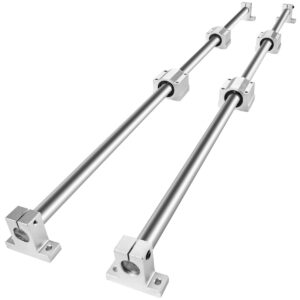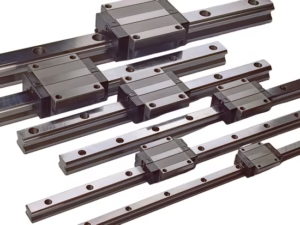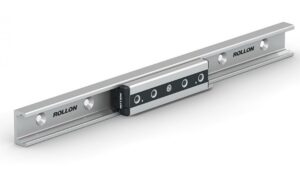Outline for “Linear Guiding”
| Section Title | Description / Focus |
|---|---|
| Introduction | Overview of linear guiding systems and their importance |
| What Is Linear Guiding? | Definition and role in mechanical systems |
| The Science Behind Linear Guiding | Motion principles and mechanical fundamentals |
| Key Components of a Linear Guiding System | Rails, bearings, carriages, and lubrication |
| Types of Linear Guiding Systems | Ball, roller, and plain guides |
| Comparison Between Linear and Rotary Motion | Understanding linear guiding in contrast to rotation |
| Working Principle of Linear Guiding | How linear guiding ensures smooth and accurate motion |
| Materials Used in Linear Guiding | Steel, aluminum, and composites |
| Design and Structure | Construction and geometric considerations |
| Preload and Friction Control | How preload affects rigidity and smoothness |
| Accuracy and Repeatability | Maintaining precision in linear movement |
| Load Capacity and Durability | Factors influencing strength and lifespan |
| Advantages of Linear Guiding Systems | Performance and operational benefits |
| Common Applications | Uses in automation, CNC, robotics, and transport |
| Linear Guiding in CNC Machines | Role in precision machining |
| Linear Guiding in Robotics | Motion control and flexibility in robotics |
| Installation and Alignment | Steps for proper setup and adjustment |
| Lubrication and Maintenance | Ensuring consistent performance |
| Common Challenges and Solutions | Addressing wear, misalignment, and contamination |
| Selecting the Right Linear Guiding System | Factors for optimal selection |
| Environmental Considerations | Handling temperature, dust, and moisture |
| Innovations and Future Trends | Smart systems, self-lubrication, and materials |
| Cost vs. Performance Analysis | Balancing price, performance, and longevity |
| FAQs | Answers to common queries |
| Conclusion | Summary and expert recommendations |
Linear Guiding
Precision motion is the heart of modern machinery—and linear guiding systems are its arteries. They enable smooth, accurate, and controlled movement of machine parts along a straight path, ensuring consistency, efficiency, and longevity in mechanical operations. From factory automation to advanced robotics, linear guiding systems are indispensable for precise linear motion in a world increasingly driven by automation.
What Is Linear Guiding?
Linear guiding refers to the technology that enables an object to move in a straight line with minimal friction and high accuracy. Unlike traditional sliding mechanisms that rely on surface contact, linear guides use rolling elements—balls or rollers—to achieve motion with minimal energy loss.
These systems form the foundation for CNC machinery, robotic arms, packaging equipment, and countless other applications where precise, smooth linear movement is essential.
The Science Behind Linear Guiding
Linear guiding is based on mechanical principles that convert force into controlled linear motion. The core idea lies in minimizing friction through rolling contact rather than sliding. This not only increases efficiency but also prevents excessive wear, heat generation, and energy waste.
By using precisely machined rails and carriages, linear guides achieve near-perfect alignment and minimal play, ensuring repeatable and stable motion across thousands of operational cycles.
Key Components of a Linear Guiding System
A typical linear guiding setup consists of several vital components:
Guide Rail: The stationary element that defines the motion path.
Carriage or Slider: The moving part that carries the load along the rail.
Rolling Elements: Balls or rollers that circulate within the carriage to enable frictionless movement.
End Caps and Seals: Prevent dust or contaminants from entering the guide mechanism.
Lubrication System: Supplies grease or oil to ensure smooth rolling contact and longevity.
Each component must work in harmony to achieve precise and durable linear motion.
Types of Linear Guiding Systems
Linear guiding systems come in various configurations, depending on the application:
Ball-Type Linear Guides: Use recirculating balls for smooth, low-friction motion; ideal for precision applications.
Roller-Type Linear Guides: Employ cylindrical rollers for high load capacity and stiffness.
Plain or Slide Guides: Rely on sliding surfaces with lubrication; suitable for short strokes and cost-sensitive systems.
Magnetic and Air Guides: Use non-contact methods for ultra-clean or high-speed environments.
Each type offers unique advantages tailored to specific industrial needs.
Comparison Between Linear and Rotary Motion
| Feature | Linear Motion | Rotary Motion |
|---|---|---|
| Path | Straight line | Circular path |
| Primary Components | Rails and carriages | Bearings and shafts |
| Friction Type | Rolling or sliding | Rotational |
| Common Use | CNC, robotics, transport | Motors, gears, turbines |
| Energy Efficiency | High due to low friction | Depends on load and speed |
Linear guiding focuses on precision along a line, whereas rotary systems specialize in continuous rotation. Many machines combine both types for complex movements.
Working Principle of Linear Guiding
In a linear guiding system, the carriage slides along the rail using rolling elements like steel balls or rollers. As the carriage moves, these elements circulate through internal channels, ensuring a continuous, low-friction contact.
This principle minimizes wear, increases stability, and allows for consistent motion under variable loads and speeds.
Materials Used in Linear Guiding
Durability and performance largely depend on material selection:
High-Carbon Steel: Offers superior strength and wear resistance.
Stainless Steel: Provides corrosion resistance for humid or chemical environments.
Aluminum Alloys: Used in lightweight applications such as automation and robotics.
Composite Materials: Reduce vibration and noise in sensitive operations.
Advanced coatings, like black oxide or chrome plating, enhance corrosion protection and lifespan.
Design and Structure
A linear guide’s structure includes precision-ground raceways that ensure consistent motion. The carriage geometry, rail shape, and contact angle determine load distribution and rigidity. For high-precision applications, multiple guides may be used in parallel to handle torque and improve balance.
Preload and Friction Control
Preload refers to the internal pressure applied to eliminate clearance between the rail and carriage. Proper preload increases rigidity, reduces vibration, and improves precision. However, excessive preload raises friction and may shorten lifespan.
Balancing preload ensures stable operation with optimal smoothness.
Accuracy and Repeatability
Accuracy determines how closely the guide follows a desired path, while repeatability measures how consistently it can return to the same position. Linear guiding systems achieve both through precision machining, controlled preload, and proper alignment, allowing them to deliver sub-micron accuracy in high-end machinery.
Load Capacity and Durability
Linear guides are engineered to handle high static and dynamic loads. Load capacity depends on the size, number of rolling elements, and contact angle. Durability is influenced by material hardness, lubrication quality, and operating conditions. With proper maintenance, linear guides can operate reliably for tens of thousands of hours.
Advantages of Linear Guiding Systems
Smooth and Precise Motion: Enables controlled linear travel with minimal deviation.
High Rigidity: Withstands heavy loads without bending or deflection.
Low Friction: Reduces energy consumption and heat generation.
Longevity: Hardened materials and efficient lubrication extend life.
Easy Integration: Compact and adaptable to various industrial designs.
Noise Reduction: Rolling elements minimize operational noise.
These benefits make linear guiding indispensable in modern machinery and automation.
Common Applications
Linear guiding systems are used in a wide variety of industries, including:
CNC Machining Centers – For accurate tool and table movement.
Industrial Robotics – For precise motion in multi-axis systems.
3D Printing and Additive Manufacturing – Ensuring layer consistency.
Medical Equipment – Enabling smooth imaging and scanning motions.
Packaging and Logistics – Supporting fast, reliable linear transfers.
Their ability to provide stable, high-precision movement makes them a standard in motion control.
Linear Guiding in CNC Machines
CNC machines demand absolute precision and stability. Linear guiding systems allow the cutting head or table to move accurately along axes while maintaining rigidity under cutting forces. This results in improved surface finish, reduced vibration, and consistent accuracy across long production runs.
Linear Guiding in Robotics
In robotic systems, linear guides facilitate precise arm movement, enabling robots to perform repetitive, high-speed operations without losing accuracy. They are critical in pick-and-place systems, assembly lines, and welding robots where both precision and reliability are paramount.
Installation and Alignment
Proper installation ensures longevity and accuracy. Steps include:
Surface Preparation: Ensure flatness and cleanliness of the mounting base.
Alignment: Use measuring tools to achieve parallel rail setup.
Mounting: Tighten screws gradually in alternating patterns.
Testing: Manually move the carriage to detect resistance or misalignment.
Lubrication: Apply the correct lubricant before operation.
Even minor misalignments can lead to uneven wear or reduced performance.
Lubrication and Maintenance
Lubrication is crucial for minimizing friction and preventing corrosion. Use recommended greases or oils compatible with the bearing material. Maintenance practices include:
Regular cleaning of rails and seals.
Checking for wear, noise, or vibration.
Periodic re-lubrication as per duty cycle.
Inspection for debris or contaminants.
Proper maintenance can extend a linear guiding system’s service life significantly.
Common Challenges and Solutions
| Problem | Cause | Solution |
|---|---|---|
| Jerky or uneven motion | Misalignment or dirt | Clean and re-align rails |
| Excessive noise | Lack of lubrication | Apply grease or replace worn parts |
| Vibration | Over-preload or loose bolts | Adjust preload and tighten fasteners |
| Corrosion | Moisture exposure | Use stainless steel or coated rails |
| Reduced accuracy | Wear or deformation | Replace damaged components |
Preventive care ensures continuous and smooth operation.
Selecting the Right Linear Guiding System
To select the best linear guiding setup, evaluate:
Load and Speed Requirements
Precision and Stiffness Needs
Operating Environment (Dust, Temperature, Vibration)
Available Space and Mounting Surface
Budget and Maintenance Constraints
Selecting the correct configuration ensures maximum performance and cost efficiency.

Environmental Considerations
Linear guiding systems must withstand environmental challenges. Sealed and coated designs protect against dust, moisture, and chemicals. For cleanroom environments, non-lubricated or vacuum-compatible guides prevent contamination. Proper selection ensures reliability under specific conditions.
Innovations and Future Trends
The future of linear guiding technology is being shaped by innovation:
Smart Sensors: Monitor temperature, load, and wear in real time.
Self-Lubricating Systems: Reduce maintenance requirements.
Advanced Coatings: Improve resistance to corrosion and wear.
Lightweight Composite Designs: Enhance speed and energy efficiency.
These advancements are revolutionizing automation, enabling faster and more reliable operations.
Cost vs. Performance Analysis
High-performance linear guiding systems may require a greater initial investment, but they provide superior accuracy, longevity, and reliability. Factoring in lower maintenance costs and longer service life, they deliver a higher return on investment compared to low-cost alternatives.
FAQs
What is the main function of linear guiding?
To enable controlled, precise linear motion with minimal friction and wear.
Are all linear guides the same?
No, they vary in size, design, material, and load capacity to fit specific applications.
How often should linear guides be lubricated?
Frequency depends on usage, speed, and environmental conditions; typically every few months.
Can linear guides operate vertically?
Yes, but they require proper preload and lubrication management to handle gravitational effects.
What causes noise in linear guides?
Noise usually indicates contamination, lack of lubrication, or misalignment.
Do linear guides wear out over time?
Yes, like any mechanical system, they wear with use—but proper maintenance can extend life significantly.
Conclusion
Linear guiding systems are the cornerstone of precision motion in today’s automated world. Their combination of rigidity, smoothness, and accuracy enables complex machinery to perform with remarkable efficiency. From robotics to machining, their role is irreplaceable in delivering repeatable and reliable linear motion. With advancements in smart materials and automation, the future of linear guiding is brighter—and smoother—than ever.
Suggested Inbound Links
Guide rail maintenance techniques
Introduction to linear bearings
CNC motion control guide
Suggested Outbound Links
ISO standards for linear motion systems
Industrial lubrication best practices



